Charles Sturt University - HRM523: Employee Consultation in Offshoring
VerifiedAdded on 2022/11/03
|18
|5336
|369
Report
AI Summary
This report critically examines the Fair Work Ombudsman's (FWO) best practice guide on employee consultation and cooperation in the workplace, specifically in the context of plant closures and offshoring in Australia. The report begins with an overview of the FWO and its role in employee relations, followed by an analysis of plant closure and offshoring trends in Australia, highlighting the impact on employee consultation. The report then explores employee consultation in other mediums and identifies gaps in the FWO's guidelines. Based on this analysis, the report provides recommendations to strengthen the FWO's best practice guide, supporting its critique with evidence from scholarly articles, recent examples of plant closures, and advice from employer and union bodies. The report concludes by emphasizing the importance of effective employee consultation for maintaining industrial harmony and promoting fair workplace practices. The report follows the guidelines set by the assignment brief and provides a detailed analysis of the topic, offering valuable insights and recommendations for strengthening the FWO's best practice guide.
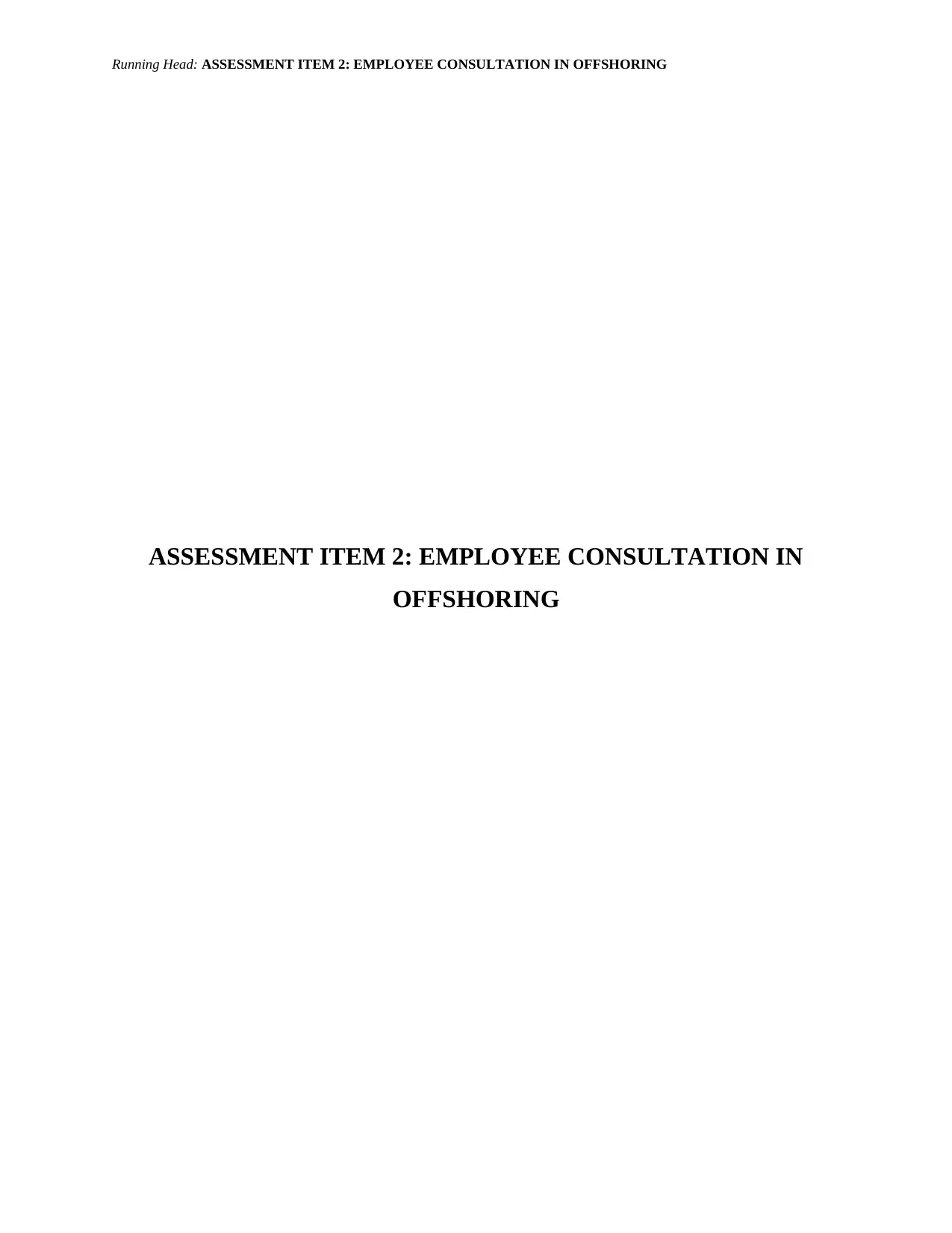
Running Head: ASSESSMENT ITEM 2: EMPLOYEE CONSULTATION IN OFFSHORING
ASSESSMENT ITEM 2: EMPLOYEE CONSULTATION IN
OFFSHORING
ASSESSMENT ITEM 2: EMPLOYEE CONSULTATION IN
OFFSHORING
Paraphrase This Document
Need a fresh take? Get an instant paraphrase of this document with our AI Paraphraser
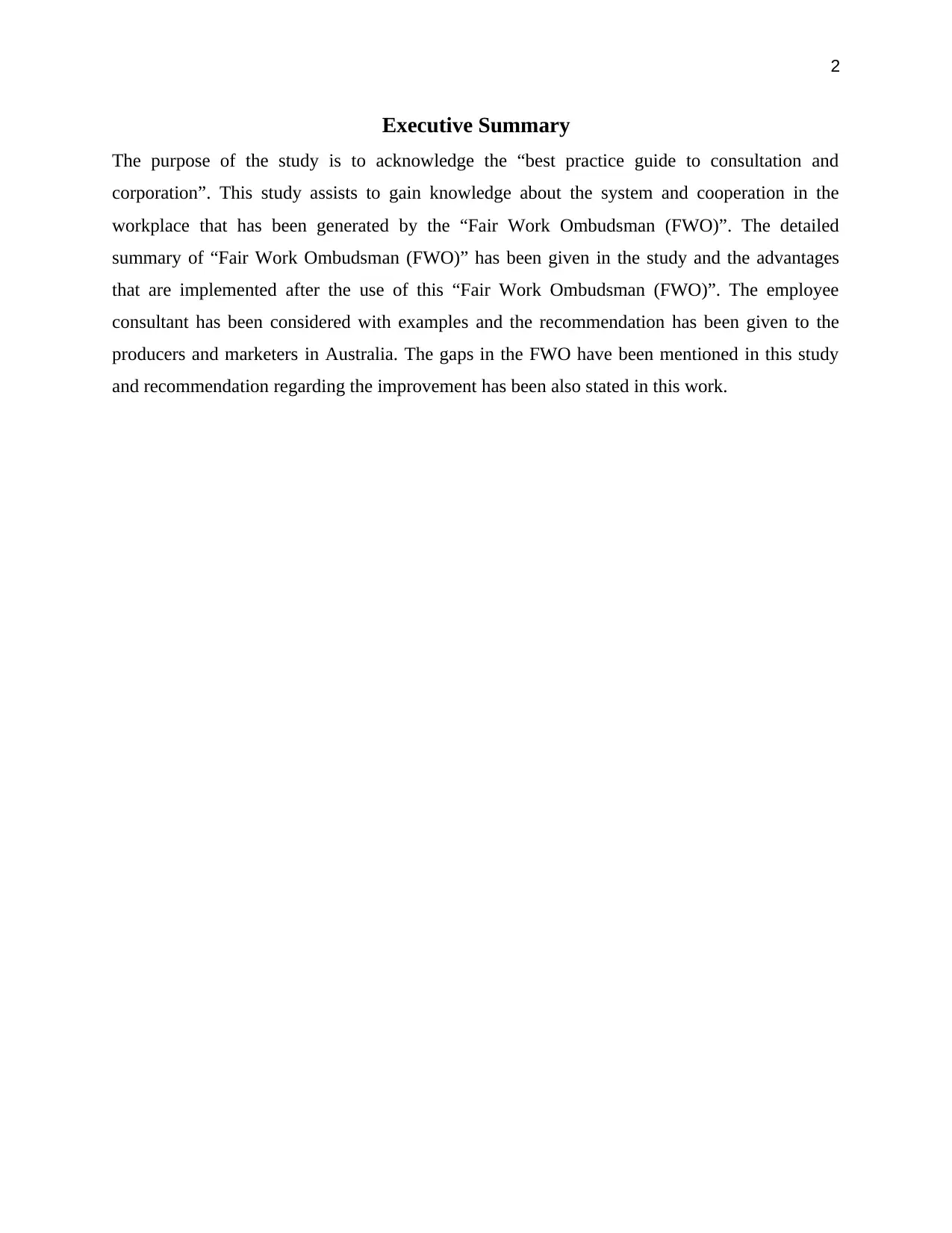
2
Executive Summary
The purpose of the study is to acknowledge the “best practice guide to consultation and
corporation”. This study assists to gain knowledge about the system and cooperation in the
workplace that has been generated by the “Fair Work Ombudsman (FWO)”. The detailed
summary of “Fair Work Ombudsman (FWO)” has been given in the study and the advantages
that are implemented after the use of this “Fair Work Ombudsman (FWO)”. The employee
consultant has been considered with examples and the recommendation has been given to the
producers and marketers in Australia. The gaps in the FWO have been mentioned in this study
and recommendation regarding the improvement has been also stated in this work.
Executive Summary
The purpose of the study is to acknowledge the “best practice guide to consultation and
corporation”. This study assists to gain knowledge about the system and cooperation in the
workplace that has been generated by the “Fair Work Ombudsman (FWO)”. The detailed
summary of “Fair Work Ombudsman (FWO)” has been given in the study and the advantages
that are implemented after the use of this “Fair Work Ombudsman (FWO)”. The employee
consultant has been considered with examples and the recommendation has been given to the
producers and marketers in Australia. The gaps in the FWO have been mentioned in this study
and recommendation regarding the improvement has been also stated in this work.
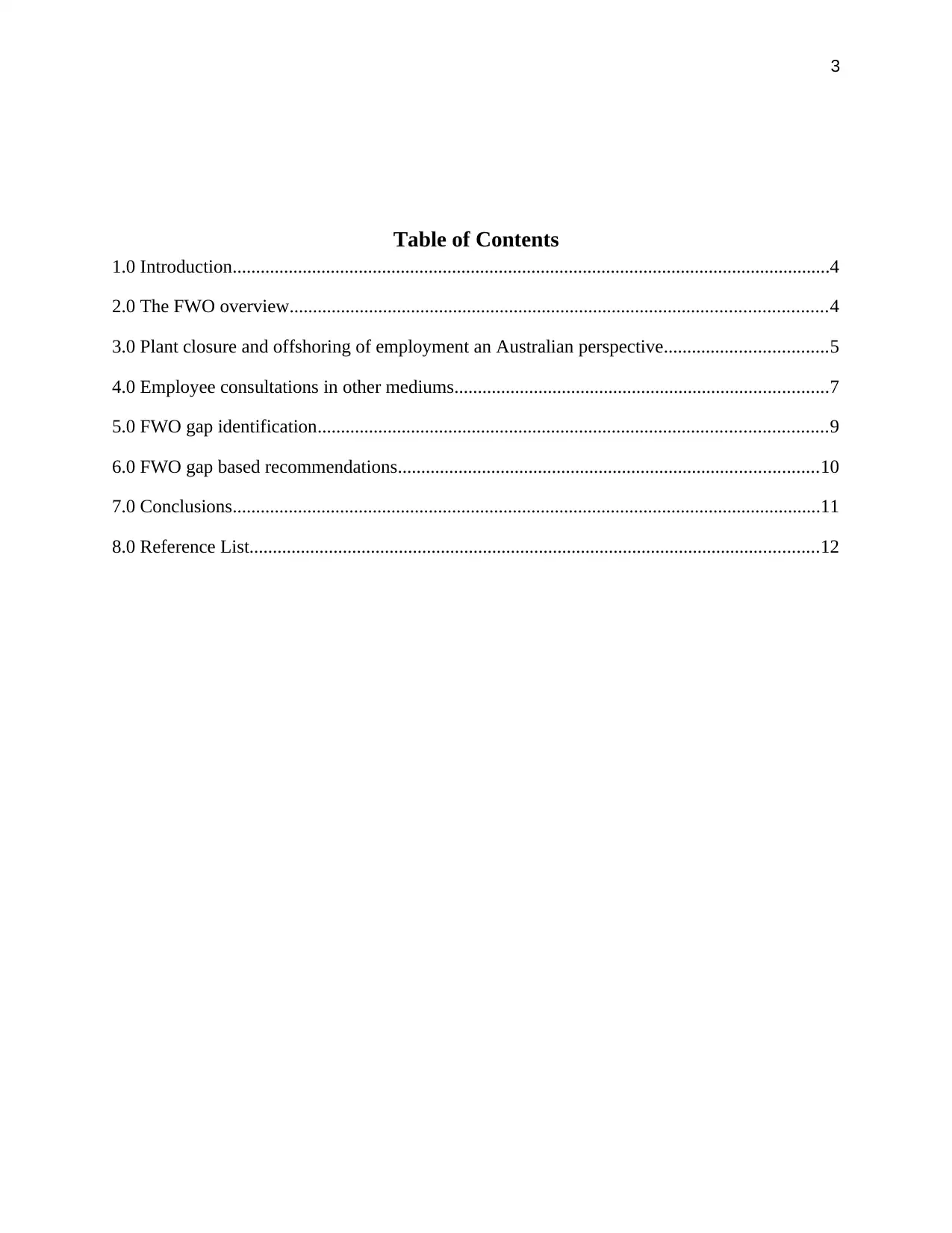
3
Table of Contents
1.0 Introduction................................................................................................................................4
2.0 The FWO overview...................................................................................................................4
3.0 Plant closure and offshoring of employment an Australian perspective...................................5
4.0 Employee consultations in other mediums................................................................................7
5.0 FWO gap identification.............................................................................................................9
6.0 FWO gap based recommendations..........................................................................................10
7.0 Conclusions..............................................................................................................................11
8.0 Reference List..........................................................................................................................12
Table of Contents
1.0 Introduction................................................................................................................................4
2.0 The FWO overview...................................................................................................................4
3.0 Plant closure and offshoring of employment an Australian perspective...................................5
4.0 Employee consultations in other mediums................................................................................7
5.0 FWO gap identification.............................................................................................................9
6.0 FWO gap based recommendations..........................................................................................10
7.0 Conclusions..............................................................................................................................11
8.0 Reference List..........................................................................................................................12
⊘ This is a preview!⊘
Do you want full access?
Subscribe today to unlock all pages.

Trusted by 1+ million students worldwide
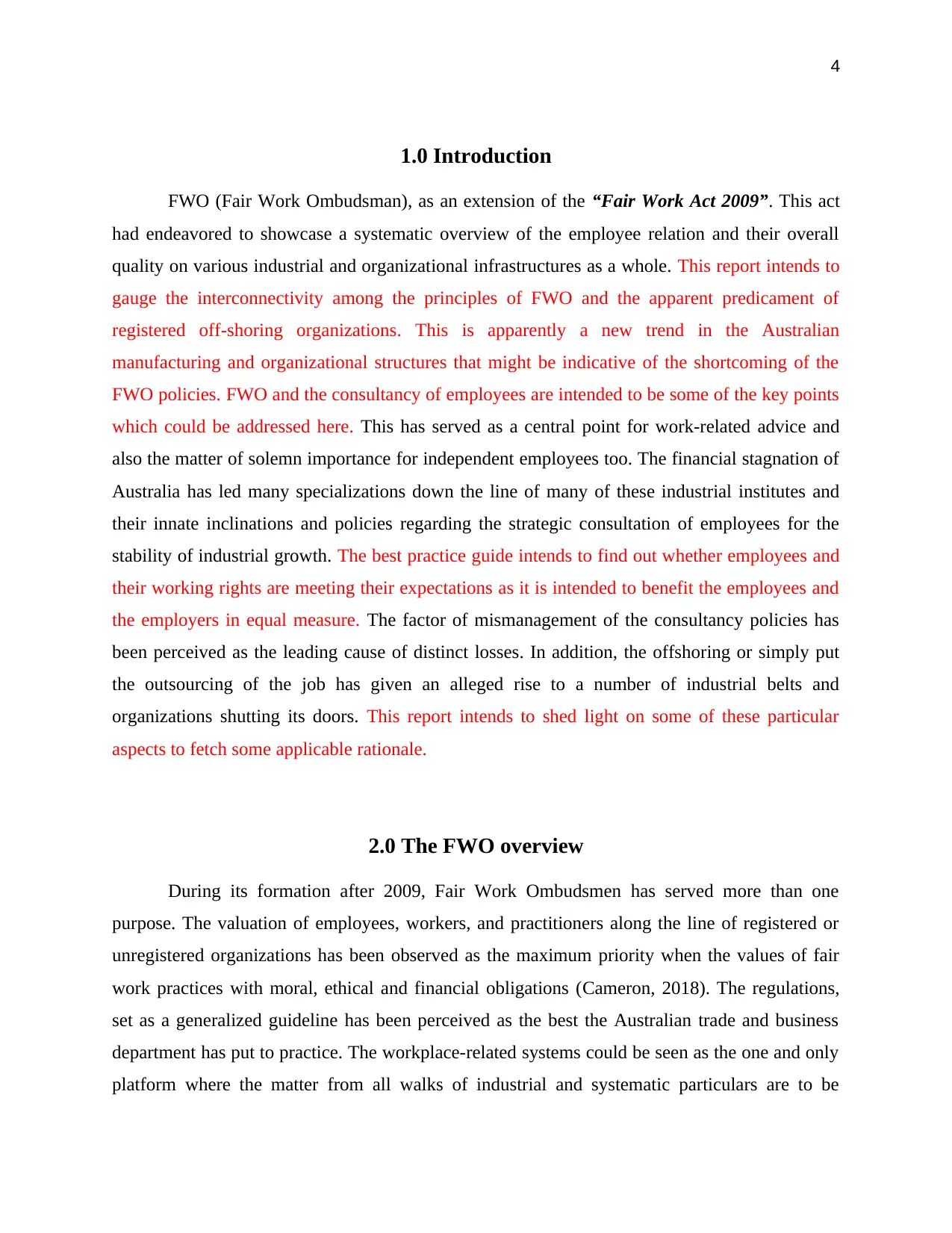
4
1.0 Introduction
FWO (Fair Work Ombudsman), as an extension of the “Fair Work Act 2009”. This act
had endeavored to showcase a systematic overview of the employee relation and their overall
quality on various industrial and organizational infrastructures as a whole. This report intends to
gauge the interconnectivity among the principles of FWO and the apparent predicament of
registered off-shoring organizations. This is apparently a new trend in the Australian
manufacturing and organizational structures that might be indicative of the shortcoming of the
FWO policies. FWO and the consultancy of employees are intended to be some of the key points
which could be addressed here. This has served as a central point for work-related advice and
also the matter of solemn importance for independent employees too. The financial stagnation of
Australia has led many specializations down the line of many of these industrial institutes and
their innate inclinations and policies regarding the strategic consultation of employees for the
stability of industrial growth. The best practice guide intends to find out whether employees and
their working rights are meeting their expectations as it is intended to benefit the employees and
the employers in equal measure. The factor of mismanagement of the consultancy policies has
been perceived as the leading cause of distinct losses. In addition, the offshoring or simply put
the outsourcing of the job has given an alleged rise to a number of industrial belts and
organizations shutting its doors. This report intends to shed light on some of these particular
aspects to fetch some applicable rationale.
2.0 The FWO overview
During its formation after 2009, Fair Work Ombudsmen has served more than one
purpose. The valuation of employees, workers, and practitioners along the line of registered or
unregistered organizations has been observed as the maximum priority when the values of fair
work practices with moral, ethical and financial obligations (Cameron, 2018). The regulations,
set as a generalized guideline has been perceived as the best the Australian trade and business
department has put to practice. The workplace-related systems could be seen as the one and only
platform where the matter from all walks of industrial and systematic particulars are to be
1.0 Introduction
FWO (Fair Work Ombudsman), as an extension of the “Fair Work Act 2009”. This act
had endeavored to showcase a systematic overview of the employee relation and their overall
quality on various industrial and organizational infrastructures as a whole. This report intends to
gauge the interconnectivity among the principles of FWO and the apparent predicament of
registered off-shoring organizations. This is apparently a new trend in the Australian
manufacturing and organizational structures that might be indicative of the shortcoming of the
FWO policies. FWO and the consultancy of employees are intended to be some of the key points
which could be addressed here. This has served as a central point for work-related advice and
also the matter of solemn importance for independent employees too. The financial stagnation of
Australia has led many specializations down the line of many of these industrial institutes and
their innate inclinations and policies regarding the strategic consultation of employees for the
stability of industrial growth. The best practice guide intends to find out whether employees and
their working rights are meeting their expectations as it is intended to benefit the employees and
the employers in equal measure. The factor of mismanagement of the consultancy policies has
been perceived as the leading cause of distinct losses. In addition, the offshoring or simply put
the outsourcing of the job has given an alleged rise to a number of industrial belts and
organizations shutting its doors. This report intends to shed light on some of these particular
aspects to fetch some applicable rationale.
2.0 The FWO overview
During its formation after 2009, Fair Work Ombudsmen has served more than one
purpose. The valuation of employees, workers, and practitioners along the line of registered or
unregistered organizations has been observed as the maximum priority when the values of fair
work practices with moral, ethical and financial obligations (Cameron, 2018). The regulations,
set as a generalized guideline has been perceived as the best the Australian trade and business
department has put to practice. The workplace-related systems could be seen as the one and only
platform where the matter from all walks of industrial and systematic particulars are to be
Paraphrase This Document
Need a fresh take? Get an instant paraphrase of this document with our AI Paraphraser
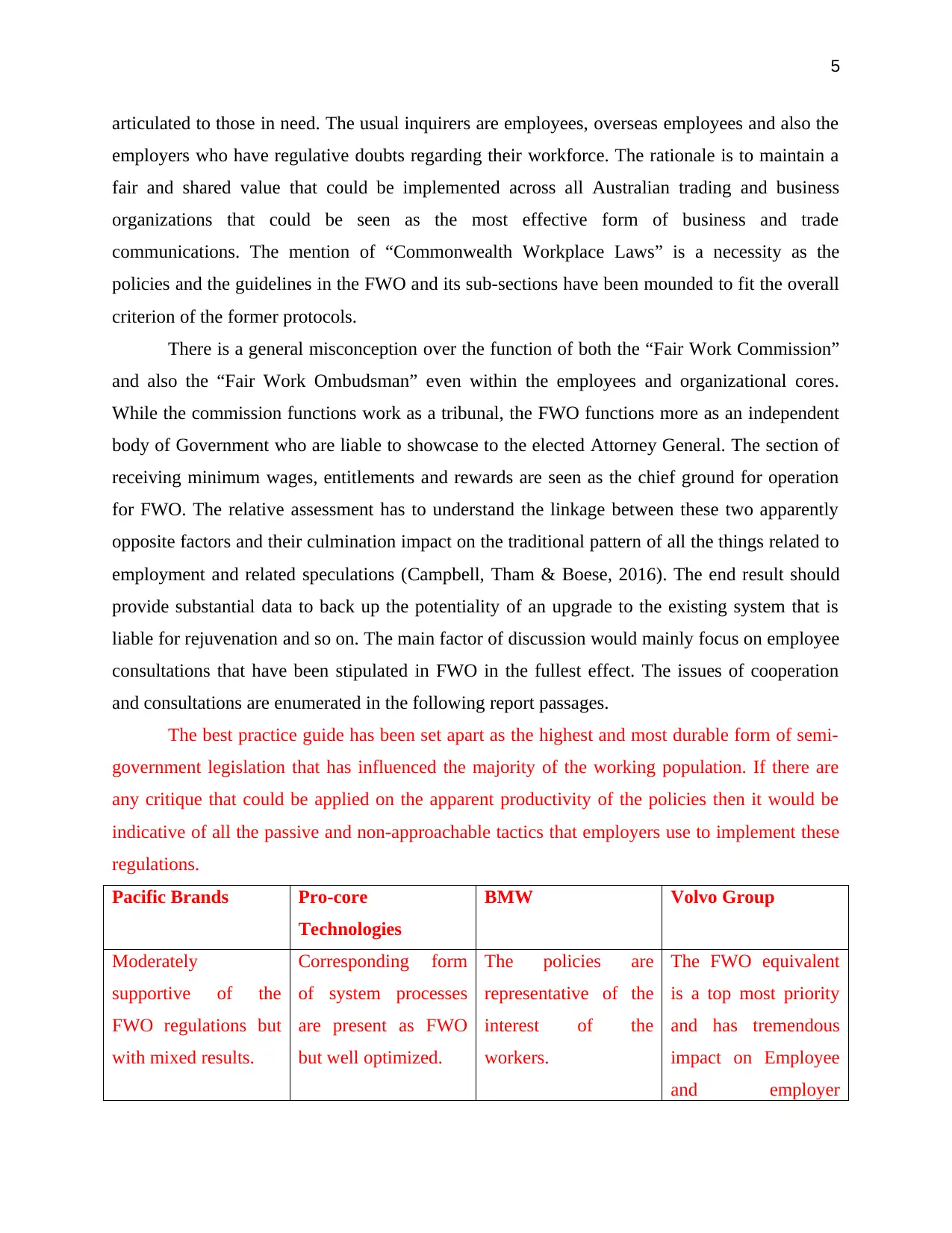
5
articulated to those in need. The usual inquirers are employees, overseas employees and also the
employers who have regulative doubts regarding their workforce. The rationale is to maintain a
fair and shared value that could be implemented across all Australian trading and business
organizations that could be seen as the most effective form of business and trade
communications. The mention of “Commonwealth Workplace Laws” is a necessity as the
policies and the guidelines in the FWO and its sub-sections have been mounded to fit the overall
criterion of the former protocols.
There is a general misconception over the function of both the “Fair Work Commission”
and also the “Fair Work Ombudsman” even within the employees and organizational cores.
While the commission functions work as a tribunal, the FWO functions more as an independent
body of Government who are liable to showcase to the elected Attorney General. The section of
receiving minimum wages, entitlements and rewards are seen as the chief ground for operation
for FWO. The relative assessment has to understand the linkage between these two apparently
opposite factors and their culmination impact on the traditional pattern of all the things related to
employment and related speculations (Campbell, Tham & Boese, 2016). The end result should
provide substantial data to back up the potentiality of an upgrade to the existing system that is
liable for rejuvenation and so on. The main factor of discussion would mainly focus on employee
consultations that have been stipulated in FWO in the fullest effect. The issues of cooperation
and consultations are enumerated in the following report passages.
The best practice guide has been set apart as the highest and most durable form of semi-
government legislation that has influenced the majority of the working population. If there are
any critique that could be applied on the apparent productivity of the policies then it would be
indicative of all the passive and non-approachable tactics that employers use to implement these
regulations.
Pacific Brands Pro-core
Technologies
BMW Volvo Group
Moderately
supportive of the
FWO regulations but
with mixed results.
Corresponding form
of system processes
are present as FWO
but well optimized.
The policies are
representative of the
interest of the
workers.
The FWO equivalent
is a top most priority
and has tremendous
impact on Employee
and employer
articulated to those in need. The usual inquirers are employees, overseas employees and also the
employers who have regulative doubts regarding their workforce. The rationale is to maintain a
fair and shared value that could be implemented across all Australian trading and business
organizations that could be seen as the most effective form of business and trade
communications. The mention of “Commonwealth Workplace Laws” is a necessity as the
policies and the guidelines in the FWO and its sub-sections have been mounded to fit the overall
criterion of the former protocols.
There is a general misconception over the function of both the “Fair Work Commission”
and also the “Fair Work Ombudsman” even within the employees and organizational cores.
While the commission functions work as a tribunal, the FWO functions more as an independent
body of Government who are liable to showcase to the elected Attorney General. The section of
receiving minimum wages, entitlements and rewards are seen as the chief ground for operation
for FWO. The relative assessment has to understand the linkage between these two apparently
opposite factors and their culmination impact on the traditional pattern of all the things related to
employment and related speculations (Campbell, Tham & Boese, 2016). The end result should
provide substantial data to back up the potentiality of an upgrade to the existing system that is
liable for rejuvenation and so on. The main factor of discussion would mainly focus on employee
consultations that have been stipulated in FWO in the fullest effect. The issues of cooperation
and consultations are enumerated in the following report passages.
The best practice guide has been set apart as the highest and most durable form of semi-
government legislation that has influenced the majority of the working population. If there are
any critique that could be applied on the apparent productivity of the policies then it would be
indicative of all the passive and non-approachable tactics that employers use to implement these
regulations.
Pacific Brands Pro-core
Technologies
BMW Volvo Group
Moderately
supportive of the
FWO regulations but
with mixed results.
Corresponding form
of system processes
are present as FWO
but well optimized.
The policies are
representative of the
interest of the
workers.
The FWO equivalent
is a top most priority
and has tremendous
impact on Employee
and employer
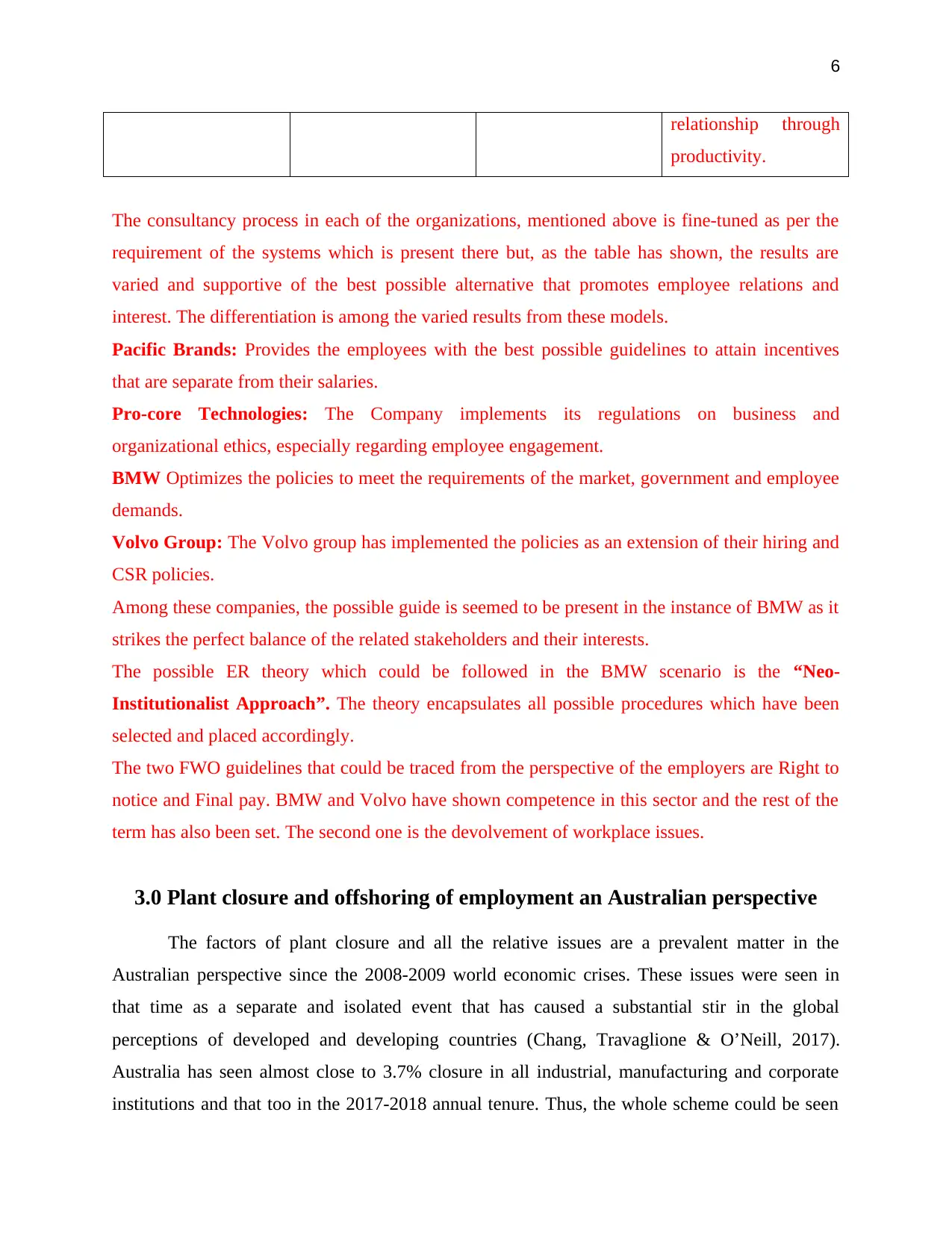
6
relationship through
productivity.
The consultancy process in each of the organizations, mentioned above is fine-tuned as per the
requirement of the systems which is present there but, as the table has shown, the results are
varied and supportive of the best possible alternative that promotes employee relations and
interest. The differentiation is among the varied results from these models.
Pacific Brands: Provides the employees with the best possible guidelines to attain incentives
that are separate from their salaries.
Pro-core Technologies: The Company implements its regulations on business and
organizational ethics, especially regarding employee engagement.
BMW Optimizes the policies to meet the requirements of the market, government and employee
demands.
Volvo Group: The Volvo group has implemented the policies as an extension of their hiring and
CSR policies.
Among these companies, the possible guide is seemed to be present in the instance of BMW as it
strikes the perfect balance of the related stakeholders and their interests.
The possible ER theory which could be followed in the BMW scenario is the “Neo-
Institutionalist Approach”. The theory encapsulates all possible procedures which have been
selected and placed accordingly.
The two FWO guidelines that could be traced from the perspective of the employers are Right to
notice and Final pay. BMW and Volvo have shown competence in this sector and the rest of the
term has also been set. The second one is the devolvement of workplace issues.
3.0 Plant closure and offshoring of employment an Australian perspective
The factors of plant closure and all the relative issues are a prevalent matter in the
Australian perspective since the 2008-2009 world economic crises. These issues were seen in
that time as a separate and isolated event that has caused a substantial stir in the global
perceptions of developed and developing countries (Chang, Travaglione & O’Neill, 2017).
Australia has seen almost close to 3.7% closure in all industrial, manufacturing and corporate
institutions and that too in the 2017-2018 annual tenure. Thus, the whole scheme could be seen
relationship through
productivity.
The consultancy process in each of the organizations, mentioned above is fine-tuned as per the
requirement of the systems which is present there but, as the table has shown, the results are
varied and supportive of the best possible alternative that promotes employee relations and
interest. The differentiation is among the varied results from these models.
Pacific Brands: Provides the employees with the best possible guidelines to attain incentives
that are separate from their salaries.
Pro-core Technologies: The Company implements its regulations on business and
organizational ethics, especially regarding employee engagement.
BMW Optimizes the policies to meet the requirements of the market, government and employee
demands.
Volvo Group: The Volvo group has implemented the policies as an extension of their hiring and
CSR policies.
Among these companies, the possible guide is seemed to be present in the instance of BMW as it
strikes the perfect balance of the related stakeholders and their interests.
The possible ER theory which could be followed in the BMW scenario is the “Neo-
Institutionalist Approach”. The theory encapsulates all possible procedures which have been
selected and placed accordingly.
The two FWO guidelines that could be traced from the perspective of the employers are Right to
notice and Final pay. BMW and Volvo have shown competence in this sector and the rest of the
term has also been set. The second one is the devolvement of workplace issues.
3.0 Plant closure and offshoring of employment an Australian perspective
The factors of plant closure and all the relative issues are a prevalent matter in the
Australian perspective since the 2008-2009 world economic crises. These issues were seen in
that time as a separate and isolated event that has caused a substantial stir in the global
perceptions of developed and developing countries (Chang, Travaglione & O’Neill, 2017).
Australia has seen almost close to 3.7% closure in all industrial, manufacturing and corporate
institutions and that too in the 2017-2018 annual tenure. Thus, the whole scheme could be seen
⊘ This is a preview!⊘
Do you want full access?
Subscribe today to unlock all pages.

Trusted by 1+ million students worldwide
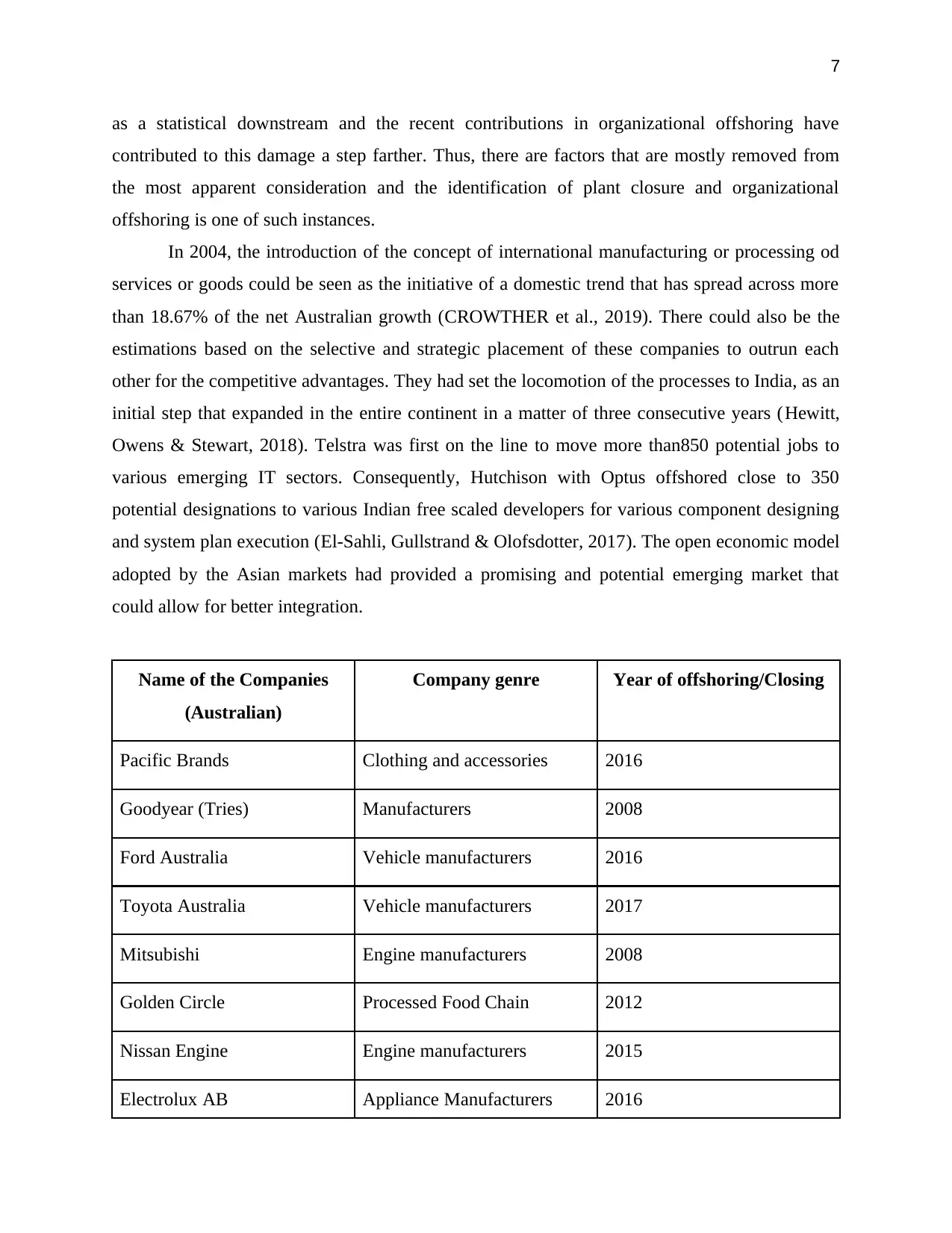
7
as a statistical downstream and the recent contributions in organizational offshoring have
contributed to this damage a step farther. Thus, there are factors that are mostly removed from
the most apparent consideration and the identification of plant closure and organizational
offshoring is one of such instances.
In 2004, the introduction of the concept of international manufacturing or processing od
services or goods could be seen as the initiative of a domestic trend that has spread across more
than 18.67% of the net Australian growth (CROWTHER et al., 2019). There could also be the
estimations based on the selective and strategic placement of these companies to outrun each
other for the competitive advantages. They had set the locomotion of the processes to India, as an
initial step that expanded in the entire continent in a matter of three consecutive years (Hewitt,
Owens & Stewart, 2018). Telstra was first on the line to move more than850 potential jobs to
various emerging IT sectors. Consequently, Hutchison with Optus offshored close to 350
potential designations to various Indian free scaled developers for various component designing
and system plan execution (El-Sahli, Gullstrand & Olofsdotter, 2017). The open economic model
adopted by the Asian markets had provided a promising and potential emerging market that
could allow for better integration.
Name of the Companies
(Australian)
Company genre Year of offshoring/Closing
Pacific Brands Clothing and accessories 2016
Goodyear (Tries) Manufacturers 2008
Ford Australia Vehicle manufacturers 2016
Toyota Australia Vehicle manufacturers 2017
Mitsubishi Engine manufacturers 2008
Golden Circle Processed Food Chain 2012
Nissan Engine Engine manufacturers 2015
Electrolux AB Appliance Manufacturers 2016
as a statistical downstream and the recent contributions in organizational offshoring have
contributed to this damage a step farther. Thus, there are factors that are mostly removed from
the most apparent consideration and the identification of plant closure and organizational
offshoring is one of such instances.
In 2004, the introduction of the concept of international manufacturing or processing od
services or goods could be seen as the initiative of a domestic trend that has spread across more
than 18.67% of the net Australian growth (CROWTHER et al., 2019). There could also be the
estimations based on the selective and strategic placement of these companies to outrun each
other for the competitive advantages. They had set the locomotion of the processes to India, as an
initial step that expanded in the entire continent in a matter of three consecutive years (Hewitt,
Owens & Stewart, 2018). Telstra was first on the line to move more than850 potential jobs to
various emerging IT sectors. Consequently, Hutchison with Optus offshored close to 350
potential designations to various Indian free scaled developers for various component designing
and system plan execution (El-Sahli, Gullstrand & Olofsdotter, 2017). The open economic model
adopted by the Asian markets had provided a promising and potential emerging market that
could allow for better integration.
Name of the Companies
(Australian)
Company genre Year of offshoring/Closing
Pacific Brands Clothing and accessories 2016
Goodyear (Tries) Manufacturers 2008
Ford Australia Vehicle manufacturers 2016
Toyota Australia Vehicle manufacturers 2017
Mitsubishi Engine manufacturers 2008
Golden Circle Processed Food Chain 2012
Nissan Engine Engine manufacturers 2015
Electrolux AB Appliance Manufacturers 2016
Paraphrase This Document
Need a fresh take? Get an instant paraphrase of this document with our AI Paraphraser
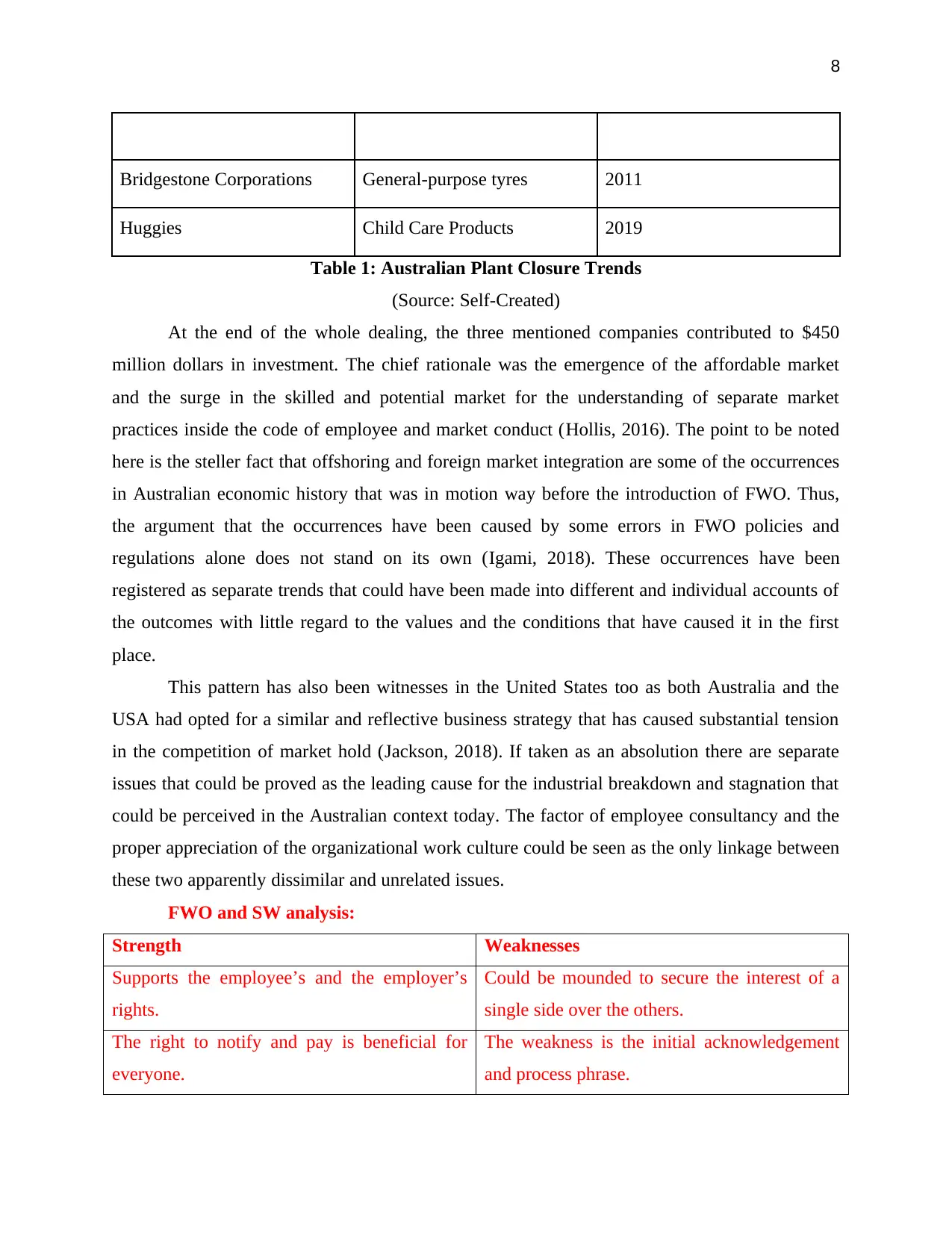
8
Bridgestone Corporations General-purpose tyres 2011
Huggies Child Care Products 2019
Table 1: Australian Plant Closure Trends
(Source: Self-Created)
At the end of the whole dealing, the three mentioned companies contributed to $450
million dollars in investment. The chief rationale was the emergence of the affordable market
and the surge in the skilled and potential market for the understanding of separate market
practices inside the code of employee and market conduct (Hollis, 2016). The point to be noted
here is the steller fact that offshoring and foreign market integration are some of the occurrences
in Australian economic history that was in motion way before the introduction of FWO. Thus,
the argument that the occurrences have been caused by some errors in FWO policies and
regulations alone does not stand on its own (Igami, 2018). These occurrences have been
registered as separate trends that could have been made into different and individual accounts of
the outcomes with little regard to the values and the conditions that have caused it in the first
place.
This pattern has also been witnesses in the United States too as both Australia and the
USA had opted for a similar and reflective business strategy that has caused substantial tension
in the competition of market hold (Jackson, 2018). If taken as an absolution there are separate
issues that could be proved as the leading cause for the industrial breakdown and stagnation that
could be perceived in the Australian context today. The factor of employee consultancy and the
proper appreciation of the organizational work culture could be seen as the only linkage between
these two apparently dissimilar and unrelated issues.
FWO and SW analysis:
Strength Weaknesses
Supports the employee’s and the employer’s
rights.
Could be mounded to secure the interest of a
single side over the others.
The right to notify and pay is beneficial for
everyone.
The weakness is the initial acknowledgement
and process phrase.
Bridgestone Corporations General-purpose tyres 2011
Huggies Child Care Products 2019
Table 1: Australian Plant Closure Trends
(Source: Self-Created)
At the end of the whole dealing, the three mentioned companies contributed to $450
million dollars in investment. The chief rationale was the emergence of the affordable market
and the surge in the skilled and potential market for the understanding of separate market
practices inside the code of employee and market conduct (Hollis, 2016). The point to be noted
here is the steller fact that offshoring and foreign market integration are some of the occurrences
in Australian economic history that was in motion way before the introduction of FWO. Thus,
the argument that the occurrences have been caused by some errors in FWO policies and
regulations alone does not stand on its own (Igami, 2018). These occurrences have been
registered as separate trends that could have been made into different and individual accounts of
the outcomes with little regard to the values and the conditions that have caused it in the first
place.
This pattern has also been witnesses in the United States too as both Australia and the
USA had opted for a similar and reflective business strategy that has caused substantial tension
in the competition of market hold (Jackson, 2018). If taken as an absolution there are separate
issues that could be proved as the leading cause for the industrial breakdown and stagnation that
could be perceived in the Australian context today. The factor of employee consultancy and the
proper appreciation of the organizational work culture could be seen as the only linkage between
these two apparently dissimilar and unrelated issues.
FWO and SW analysis:
Strength Weaknesses
Supports the employee’s and the employer’s
rights.
Could be mounded to secure the interest of a
single side over the others.
The right to notify and pay is beneficial for
everyone.
The weakness is the initial acknowledgement
and process phrase.
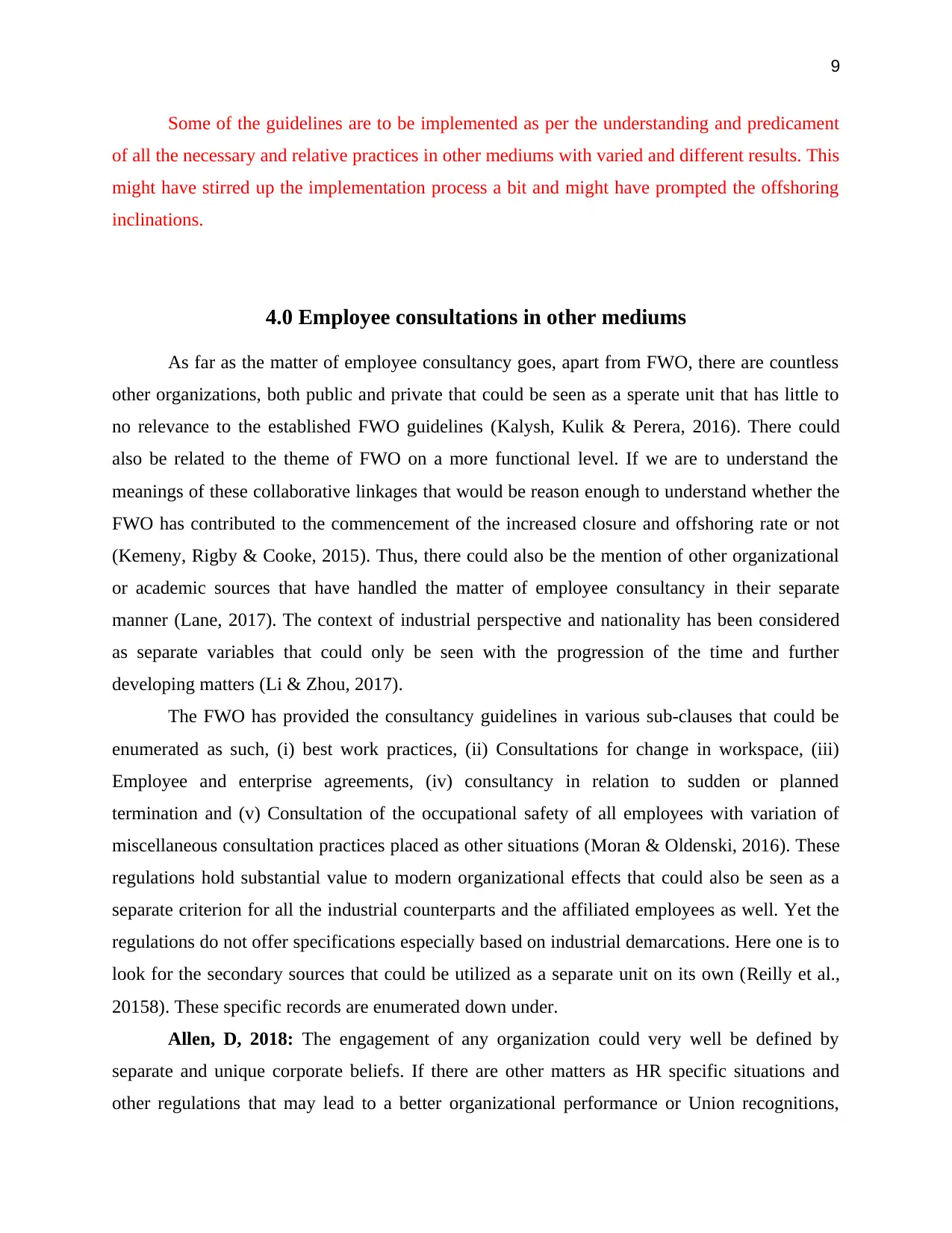
9
Some of the guidelines are to be implemented as per the understanding and predicament
of all the necessary and relative practices in other mediums with varied and different results. This
might have stirred up the implementation process a bit and might have prompted the offshoring
inclinations.
4.0 Employee consultations in other mediums
As far as the matter of employee consultancy goes, apart from FWO, there are countless
other organizations, both public and private that could be seen as a sperate unit that has little to
no relevance to the established FWO guidelines (Kalysh, Kulik & Perera, 2016). There could
also be related to the theme of FWO on a more functional level. If we are to understand the
meanings of these collaborative linkages that would be reason enough to understand whether the
FWO has contributed to the commencement of the increased closure and offshoring rate or not
(Kemeny, Rigby & Cooke, 2015). Thus, there could also be the mention of other organizational
or academic sources that have handled the matter of employee consultancy in their separate
manner (Lane, 2017). The context of industrial perspective and nationality has been considered
as separate variables that could only be seen with the progression of the time and further
developing matters (Li & Zhou, 2017).
The FWO has provided the consultancy guidelines in various sub-clauses that could be
enumerated as such, (i) best work practices, (ii) Consultations for change in workspace, (iii)
Employee and enterprise agreements, (iv) consultancy in relation to sudden or planned
termination and (v) Consultation of the occupational safety of all employees with variation of
miscellaneous consultation practices placed as other situations (Moran & Oldenski, 2016). These
regulations hold substantial value to modern organizational effects that could also be seen as a
separate criterion for all the industrial counterparts and the affiliated employees as well. Yet the
regulations do not offer specifications especially based on industrial demarcations. Here one is to
look for the secondary sources that could be utilized as a separate unit on its own (Reilly et al.,
20158). These specific records are enumerated down under.
Allen, D, 2018: The engagement of any organization could very well be defined by
separate and unique corporate beliefs. If there are other matters as HR specific situations and
other regulations that may lead to a better organizational performance or Union recognitions,
Some of the guidelines are to be implemented as per the understanding and predicament
of all the necessary and relative practices in other mediums with varied and different results. This
might have stirred up the implementation process a bit and might have prompted the offshoring
inclinations.
4.0 Employee consultations in other mediums
As far as the matter of employee consultancy goes, apart from FWO, there are countless
other organizations, both public and private that could be seen as a sperate unit that has little to
no relevance to the established FWO guidelines (Kalysh, Kulik & Perera, 2016). There could
also be related to the theme of FWO on a more functional level. If we are to understand the
meanings of these collaborative linkages that would be reason enough to understand whether the
FWO has contributed to the commencement of the increased closure and offshoring rate or not
(Kemeny, Rigby & Cooke, 2015). Thus, there could also be the mention of other organizational
or academic sources that have handled the matter of employee consultancy in their separate
manner (Lane, 2017). The context of industrial perspective and nationality has been considered
as separate variables that could only be seen with the progression of the time and further
developing matters (Li & Zhou, 2017).
The FWO has provided the consultancy guidelines in various sub-clauses that could be
enumerated as such, (i) best work practices, (ii) Consultations for change in workspace, (iii)
Employee and enterprise agreements, (iv) consultancy in relation to sudden or planned
termination and (v) Consultation of the occupational safety of all employees with variation of
miscellaneous consultation practices placed as other situations (Moran & Oldenski, 2016). These
regulations hold substantial value to modern organizational effects that could also be seen as a
separate criterion for all the industrial counterparts and the affiliated employees as well. Yet the
regulations do not offer specifications especially based on industrial demarcations. Here one is to
look for the secondary sources that could be utilized as a separate unit on its own (Reilly et al.,
20158). These specific records are enumerated down under.
Allen, D, 2018: The engagement of any organization could very well be defined by
separate and unique corporate beliefs. If there are other matters as HR specific situations and
other regulations that may lead to a better organizational performance or Union recognitions,
⊘ This is a preview!⊘
Do you want full access?
Subscribe today to unlock all pages.

Trusted by 1+ million students worldwide
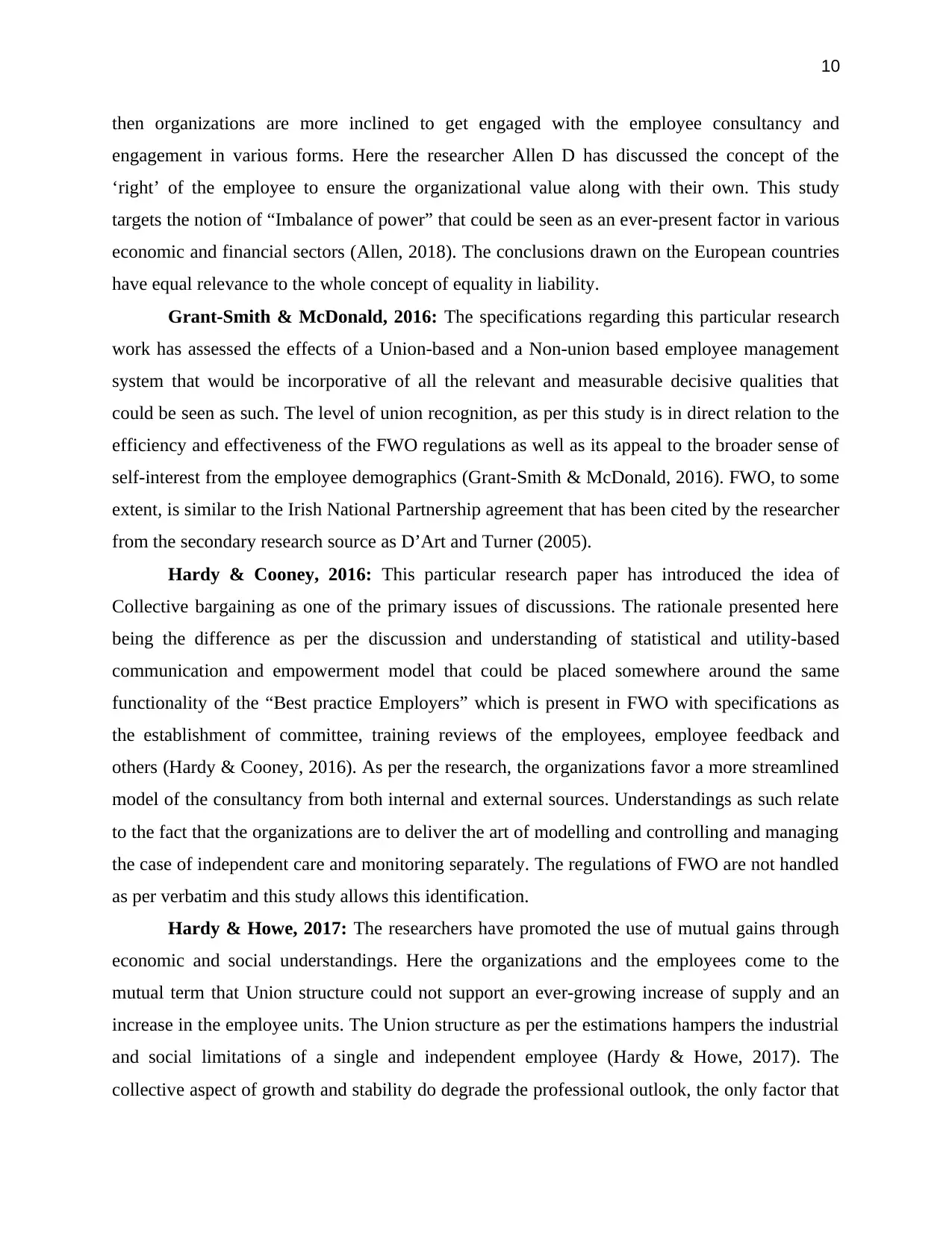
10
then organizations are more inclined to get engaged with the employee consultancy and
engagement in various forms. Here the researcher Allen D has discussed the concept of the
‘right’ of the employee to ensure the organizational value along with their own. This study
targets the notion of “Imbalance of power” that could be seen as an ever-present factor in various
economic and financial sectors (Allen, 2018). The conclusions drawn on the European countries
have equal relevance to the whole concept of equality in liability.
Grant-Smith & McDonald, 2016: The specifications regarding this particular research
work has assessed the effects of a Union-based and a Non-union based employee management
system that would be incorporative of all the relevant and measurable decisive qualities that
could be seen as such. The level of union recognition, as per this study is in direct relation to the
efficiency and effectiveness of the FWO regulations as well as its appeal to the broader sense of
self-interest from the employee demographics (Grant-Smith & McDonald, 2016). FWO, to some
extent, is similar to the Irish National Partnership agreement that has been cited by the researcher
from the secondary research source as D’Art and Turner (2005).
Hardy & Cooney, 2016: This particular research paper has introduced the idea of
Collective bargaining as one of the primary issues of discussions. The rationale presented here
being the difference as per the discussion and understanding of statistical and utility-based
communication and empowerment model that could be placed somewhere around the same
functionality of the “Best practice Employers” which is present in FWO with specifications as
the establishment of committee, training reviews of the employees, employee feedback and
others (Hardy & Cooney, 2016). As per the research, the organizations favor a more streamlined
model of the consultancy from both internal and external sources. Understandings as such relate
to the fact that the organizations are to deliver the art of modelling and controlling and managing
the case of independent care and monitoring separately. The regulations of FWO are not handled
as per verbatim and this study allows this identification.
Hardy & Howe, 2017: The researchers have promoted the use of mutual gains through
economic and social understandings. Here the organizations and the employees come to the
mutual term that Union structure could not support an ever-growing increase of supply and an
increase in the employee units. The Union structure as per the estimations hampers the industrial
and social limitations of a single and independent employee (Hardy & Howe, 2017). The
collective aspect of growth and stability do degrade the professional outlook, the only factor that
then organizations are more inclined to get engaged with the employee consultancy and
engagement in various forms. Here the researcher Allen D has discussed the concept of the
‘right’ of the employee to ensure the organizational value along with their own. This study
targets the notion of “Imbalance of power” that could be seen as an ever-present factor in various
economic and financial sectors (Allen, 2018). The conclusions drawn on the European countries
have equal relevance to the whole concept of equality in liability.
Grant-Smith & McDonald, 2016: The specifications regarding this particular research
work has assessed the effects of a Union-based and a Non-union based employee management
system that would be incorporative of all the relevant and measurable decisive qualities that
could be seen as such. The level of union recognition, as per this study is in direct relation to the
efficiency and effectiveness of the FWO regulations as well as its appeal to the broader sense of
self-interest from the employee demographics (Grant-Smith & McDonald, 2016). FWO, to some
extent, is similar to the Irish National Partnership agreement that has been cited by the researcher
from the secondary research source as D’Art and Turner (2005).
Hardy & Cooney, 2016: This particular research paper has introduced the idea of
Collective bargaining as one of the primary issues of discussions. The rationale presented here
being the difference as per the discussion and understanding of statistical and utility-based
communication and empowerment model that could be placed somewhere around the same
functionality of the “Best practice Employers” which is present in FWO with specifications as
the establishment of committee, training reviews of the employees, employee feedback and
others (Hardy & Cooney, 2016). As per the research, the organizations favor a more streamlined
model of the consultancy from both internal and external sources. Understandings as such relate
to the fact that the organizations are to deliver the art of modelling and controlling and managing
the case of independent care and monitoring separately. The regulations of FWO are not handled
as per verbatim and this study allows this identification.
Hardy & Howe, 2017: The researchers have promoted the use of mutual gains through
economic and social understandings. Here the organizations and the employees come to the
mutual term that Union structure could not support an ever-growing increase of supply and an
increase in the employee units. The Union structure as per the estimations hampers the industrial
and social limitations of a single and independent employee (Hardy & Howe, 2017). The
collective aspect of growth and stability do degrade the professional outlook, the only factor that
Paraphrase This Document
Need a fresh take? Get an instant paraphrase of this document with our AI Paraphraser
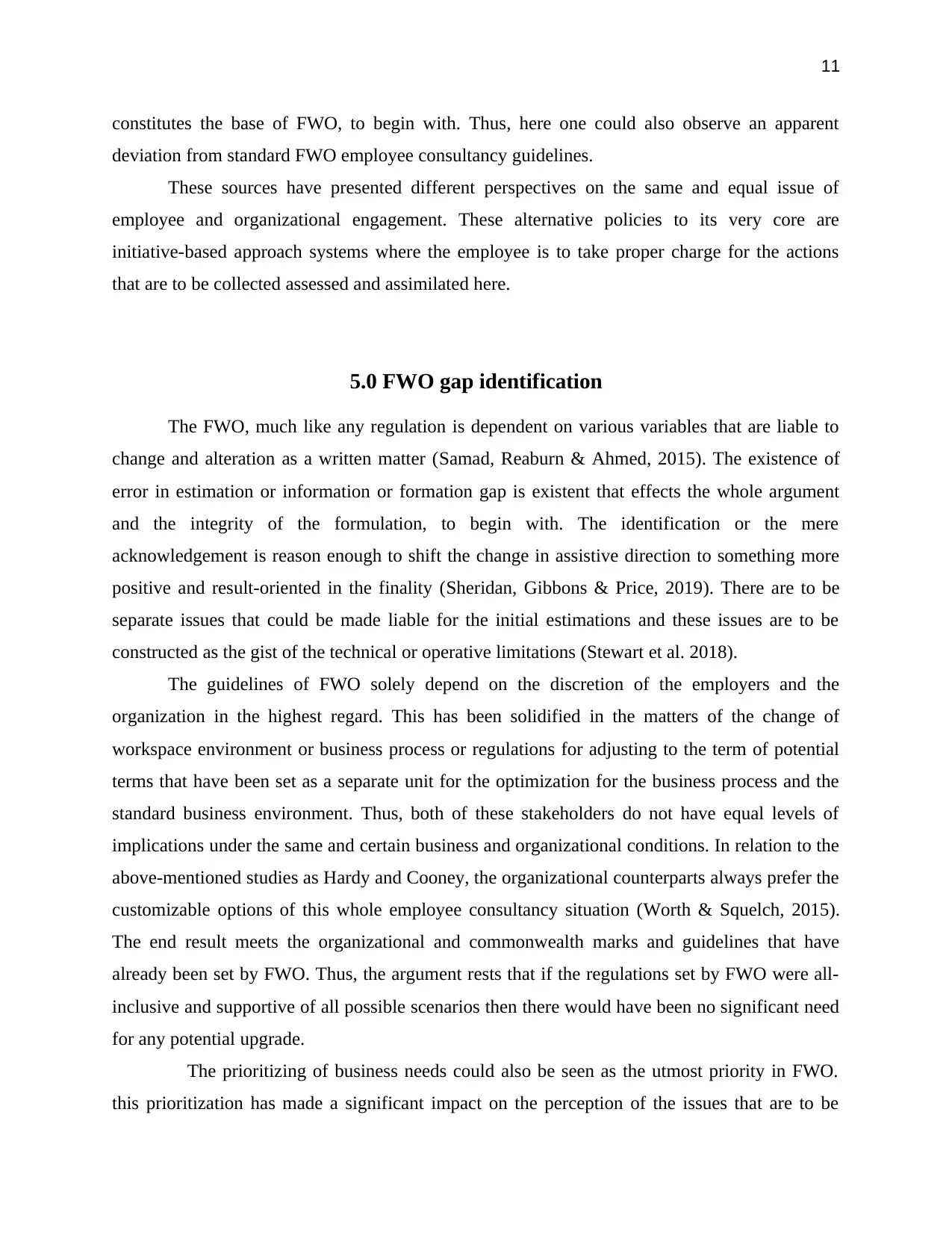
11
constitutes the base of FWO, to begin with. Thus, here one could also observe an apparent
deviation from standard FWO employee consultancy guidelines.
These sources have presented different perspectives on the same and equal issue of
employee and organizational engagement. These alternative policies to its very core are
initiative-based approach systems where the employee is to take proper charge for the actions
that are to be collected assessed and assimilated here.
5.0 FWO gap identification
The FWO, much like any regulation is dependent on various variables that are liable to
change and alteration as a written matter (Samad, Reaburn & Ahmed, 2015). The existence of
error in estimation or information or formation gap is existent that effects the whole argument
and the integrity of the formulation, to begin with. The identification or the mere
acknowledgement is reason enough to shift the change in assistive direction to something more
positive and result-oriented in the finality (Sheridan, Gibbons & Price, 2019). There are to be
separate issues that could be made liable for the initial estimations and these issues are to be
constructed as the gist of the technical or operative limitations (Stewart et al. 2018).
The guidelines of FWO solely depend on the discretion of the employers and the
organization in the highest regard. This has been solidified in the matters of the change of
workspace environment or business process or regulations for adjusting to the term of potential
terms that have been set as a separate unit for the optimization for the business process and the
standard business environment. Thus, both of these stakeholders do not have equal levels of
implications under the same and certain business and organizational conditions. In relation to the
above-mentioned studies as Hardy and Cooney, the organizational counterparts always prefer the
customizable options of this whole employee consultancy situation (Worth & Squelch, 2015).
The end result meets the organizational and commonwealth marks and guidelines that have
already been set by FWO. Thus, the argument rests that if the regulations set by FWO were all-
inclusive and supportive of all possible scenarios then there would have been no significant need
for any potential upgrade.
The prioritizing of business needs could also be seen as the utmost priority in FWO.
this prioritization has made a significant impact on the perception of the issues that are to be
constitutes the base of FWO, to begin with. Thus, here one could also observe an apparent
deviation from standard FWO employee consultancy guidelines.
These sources have presented different perspectives on the same and equal issue of
employee and organizational engagement. These alternative policies to its very core are
initiative-based approach systems where the employee is to take proper charge for the actions
that are to be collected assessed and assimilated here.
5.0 FWO gap identification
The FWO, much like any regulation is dependent on various variables that are liable to
change and alteration as a written matter (Samad, Reaburn & Ahmed, 2015). The existence of
error in estimation or information or formation gap is existent that effects the whole argument
and the integrity of the formulation, to begin with. The identification or the mere
acknowledgement is reason enough to shift the change in assistive direction to something more
positive and result-oriented in the finality (Sheridan, Gibbons & Price, 2019). There are to be
separate issues that could be made liable for the initial estimations and these issues are to be
constructed as the gist of the technical or operative limitations (Stewart et al. 2018).
The guidelines of FWO solely depend on the discretion of the employers and the
organization in the highest regard. This has been solidified in the matters of the change of
workspace environment or business process or regulations for adjusting to the term of potential
terms that have been set as a separate unit for the optimization for the business process and the
standard business environment. Thus, both of these stakeholders do not have equal levels of
implications under the same and certain business and organizational conditions. In relation to the
above-mentioned studies as Hardy and Cooney, the organizational counterparts always prefer the
customizable options of this whole employee consultancy situation (Worth & Squelch, 2015).
The end result meets the organizational and commonwealth marks and guidelines that have
already been set by FWO. Thus, the argument rests that if the regulations set by FWO were all-
inclusive and supportive of all possible scenarios then there would have been no significant need
for any potential upgrade.
The prioritizing of business needs could also be seen as the utmost priority in FWO.
this prioritization has made a significant impact on the perception of the issues that are to be
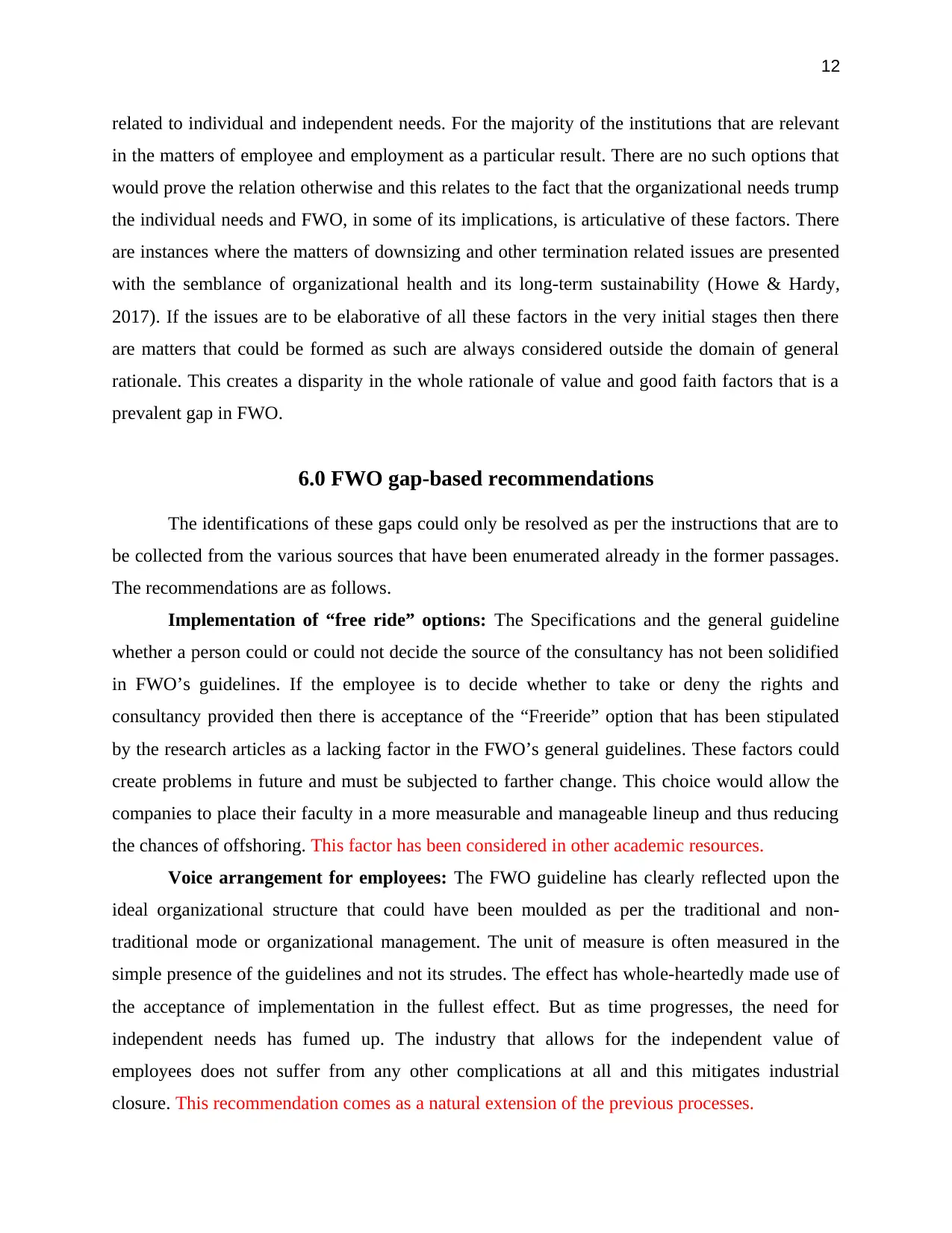
12
related to individual and independent needs. For the majority of the institutions that are relevant
in the matters of employee and employment as a particular result. There are no such options that
would prove the relation otherwise and this relates to the fact that the organizational needs trump
the individual needs and FWO, in some of its implications, is articulative of these factors. There
are instances where the matters of downsizing and other termination related issues are presented
with the semblance of organizational health and its long-term sustainability (Howe & Hardy,
2017). If the issues are to be elaborative of all these factors in the very initial stages then there
are matters that could be formed as such are always considered outside the domain of general
rationale. This creates a disparity in the whole rationale of value and good faith factors that is a
prevalent gap in FWO.
6.0 FWO gap-based recommendations
The identifications of these gaps could only be resolved as per the instructions that are to
be collected from the various sources that have been enumerated already in the former passages.
The recommendations are as follows.
Implementation of “free ride” options: The Specifications and the general guideline
whether a person could or could not decide the source of the consultancy has not been solidified
in FWO’s guidelines. If the employee is to decide whether to take or deny the rights and
consultancy provided then there is acceptance of the “Freeride” option that has been stipulated
by the research articles as a lacking factor in the FWO’s general guidelines. These factors could
create problems in future and must be subjected to farther change. This choice would allow the
companies to place their faculty in a more measurable and manageable lineup and thus reducing
the chances of offshoring. This factor has been considered in other academic resources.
Voice arrangement for employees: The FWO guideline has clearly reflected upon the
ideal organizational structure that could have been moulded as per the traditional and non-
traditional mode or organizational management. The unit of measure is often measured in the
simple presence of the guidelines and not its strudes. The effect has whole-heartedly made use of
the acceptance of implementation in the fullest effect. But as time progresses, the need for
independent needs has fumed up. The industry that allows for the independent value of
employees does not suffer from any other complications at all and this mitigates industrial
closure. This recommendation comes as a natural extension of the previous processes.
related to individual and independent needs. For the majority of the institutions that are relevant
in the matters of employee and employment as a particular result. There are no such options that
would prove the relation otherwise and this relates to the fact that the organizational needs trump
the individual needs and FWO, in some of its implications, is articulative of these factors. There
are instances where the matters of downsizing and other termination related issues are presented
with the semblance of organizational health and its long-term sustainability (Howe & Hardy,
2017). If the issues are to be elaborative of all these factors in the very initial stages then there
are matters that could be formed as such are always considered outside the domain of general
rationale. This creates a disparity in the whole rationale of value and good faith factors that is a
prevalent gap in FWO.
6.0 FWO gap-based recommendations
The identifications of these gaps could only be resolved as per the instructions that are to
be collected from the various sources that have been enumerated already in the former passages.
The recommendations are as follows.
Implementation of “free ride” options: The Specifications and the general guideline
whether a person could or could not decide the source of the consultancy has not been solidified
in FWO’s guidelines. If the employee is to decide whether to take or deny the rights and
consultancy provided then there is acceptance of the “Freeride” option that has been stipulated
by the research articles as a lacking factor in the FWO’s general guidelines. These factors could
create problems in future and must be subjected to farther change. This choice would allow the
companies to place their faculty in a more measurable and manageable lineup and thus reducing
the chances of offshoring. This factor has been considered in other academic resources.
Voice arrangement for employees: The FWO guideline has clearly reflected upon the
ideal organizational structure that could have been moulded as per the traditional and non-
traditional mode or organizational management. The unit of measure is often measured in the
simple presence of the guidelines and not its strudes. The effect has whole-heartedly made use of
the acceptance of implementation in the fullest effect. But as time progresses, the need for
independent needs has fumed up. The industry that allows for the independent value of
employees does not suffer from any other complications at all and this mitigates industrial
closure. This recommendation comes as a natural extension of the previous processes.
⊘ This is a preview!⊘
Do you want full access?
Subscribe today to unlock all pages.

Trusted by 1+ million students worldwide
1 out of 18
Related Documents
Your All-in-One AI-Powered Toolkit for Academic Success.
+13062052269
info@desklib.com
Available 24*7 on WhatsApp / Email
![[object Object]](/_next/static/media/star-bottom.7253800d.svg)
Unlock your academic potential
Copyright © 2020–2025 A2Z Services. All Rights Reserved. Developed and managed by ZUCOL.





